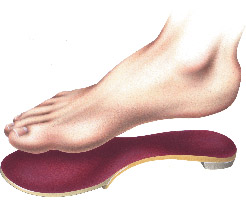
|  |

 |
|
|

|
What are they?
Foot orthotics are
supportive devices that are designed specifically for the purpose of
controlling foot motion, improving one's postural stability, reducing shock
impact, and/or improving weight distribution. In most c ases,
these devices are functional in the sense
that they also improve
one's biomechanical performance
during gait. A plaster impression is taken of your feet and
used in the selection and fitting of a prescription orthotic. The particular
information regarding anticipated cost, durability and use may vary
depending upon the type of orthotic and should be discussed with your foot
specialist. ases,
these devices are functional in the sense
that they also improve
one's biomechanical performance
during gait. A plaster impression is taken of your feet and
used in the selection and fitting of a prescription orthotic. The particular
information regarding anticipated cost, durability and use may vary
depending upon the type of orthotic and should be discussed with your foot
specialist.
What do they do?
Imagine if you will, standing
barefoot in moist sand with the arch being filled by the smooth sandy
undersurface. The heel and ball of the foot leaves a mild depression in the
sand while the toes grip the ground without resistance. If one could stand like this for lengthy periods
of time, he or she would probably not have sore feet, would experience less
fatigue and probably would not have many of those commonly
encountered forefoot skin problems such as corns, calluses and ingrown
nails. The problems come from standing on cement, asphalt or other
non-yielding surfaces. Other causes for foot problems include wearing
confining shoes, which further limit foot flexibility, and from lengthy
periods of ambulation, which add fatigue and strain to one's body.
ground without resistance. If one could stand like this for lengthy periods
of time, he or she would probably not have sore feet, would experience less
fatigue and probably would not have many of those commonly
encountered forefoot skin problems such as corns, calluses and ingrown
nails. The problems come from standing on cement, asphalt or other
non-yielding surfaces. Other causes for foot problems include wearing
confining shoes, which further limit foot flexibility, and from lengthy
periods of ambulation, which add fatigue and strain to one's body.
Orthotics assist in
restoring supportive comfort by bringing the ground surface up to the foot.
They serve to improve postural stability, distribute one's weight more
evenly and improve the mechanical functioning of the foot and ankle.
Although orthotics do not cure every ache and pain in the foot, they are a
wonderful approach in providing maximum comfort through improved
biomechanics. Standing comfortably in sand is not necessarily an unreachable
feeling even while wearing your everyday shoes.
|